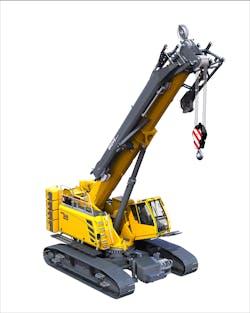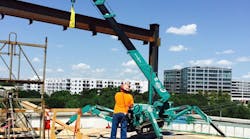The GHC85 Grove crane is a new model of telescopic crawler crane with a lift capacity of 85 tons.
Frame-mounted jacks and counterweight lifting cylinders enable the Grove crane to self-assemble, which can be controlled via a wireless remote. It can be transported to the jobsite in just three loads, or four loads when its crawlers are carried separately.
It can maintain 100 percent pick-and-carry capabilities on inclines up to 4 degrees. The crane has 36-inch triple-bar grouser shoes that produce ground bearing pressures as low as 13.2 psi without load, and as high as 24.9 psi with load.
The crane’s several track span settings (covering both symmetrical and asymmetrical configurations) are made possible by the hydraulically extendable and retractable cross members. Maximum track span is 16.7 feet, but one track can be at 100 percent and the other at 50 percent for picking in confined spaces, according to the company.
A 249-horsepower Cummins B6.7L Tier 4-F engine powers the two-speed hydrostatic drive, giving the GHC85 a maximum speed of 1.43 mph in high range, while creep speeds top out at 0.55 mph in low range.
Offering elevations from -3 to +80.5 degrees, the main boom length covers 36.1 to 137.7 feet. Its five sections are adjusted via a four-stage cylinder. A 49.3-foot bi-fold swingaway standard boom extension is offsettable at 0 , 20, and 40 degrees. A 10-foot heavy-duty jib with 10-degree offset is another option, and it’s stowable on the left-hand side of the boom.
The main and auxiliary hoists’ piston motor and grooved drum facilitate two-speed spooling for smooth operation, with 591 feet of 20-mm wire rope providing a maximum permissible single line pull of 15,876 pounds. The maximum single line speed is 360 fpm.
Although the hoists are mounted over the rear counterweight, the in-cab monitor with a 7-inch screen provides an operator a way to closely monitor hoist operation. Standard rear and right-hand cameras improve awareness for the operator. Engine bay sound insulation enables quiet communication with riggers on the job site.

